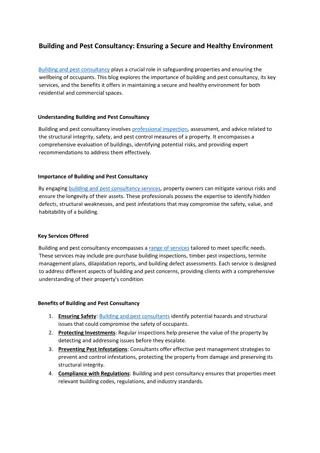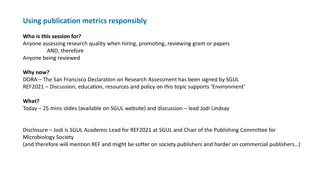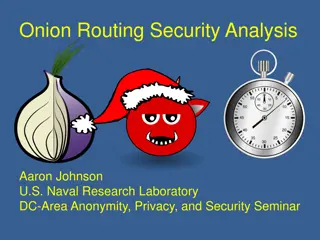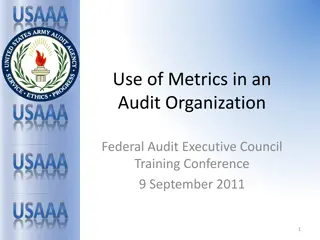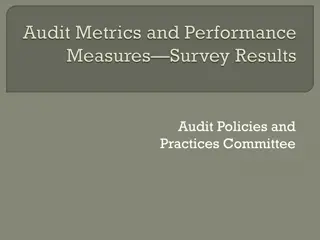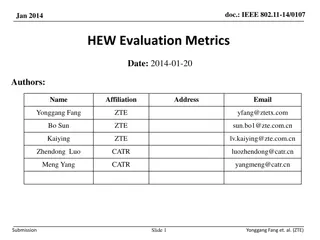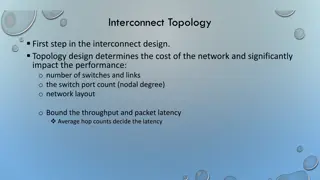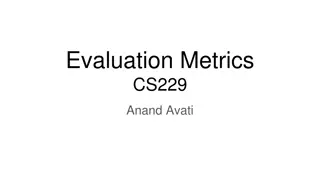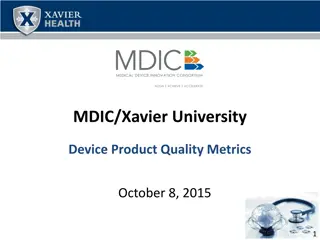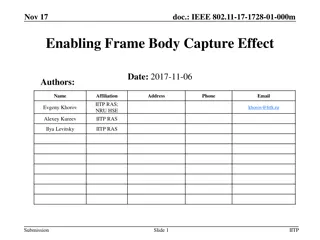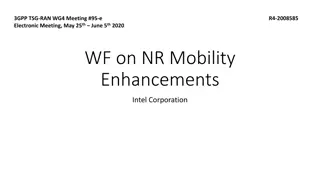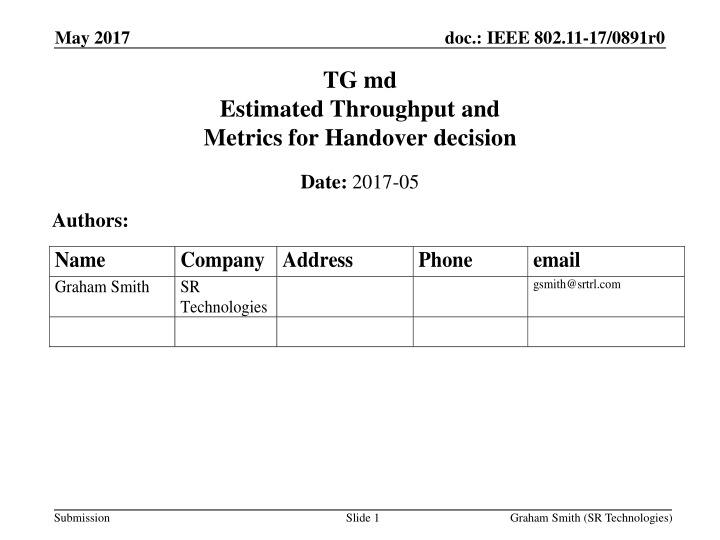
IEEE 802.11-17/0891r0: Estimated Throughput Metrics Discussion
Explore the discussion on estimated throughput metrics for handover decisions in wireless networks as outlined in the IEEE 802.11-17/0891r0 document presented by Graham Smith from SR Technologies. The presentation delves into defining accuracy requirements and additional metrics to support various features like LWA activation, mobility across WLANs cells, and traffic scheduling decisions based on Clause 11.46 of IEEE Std 802.11. Join the conversation to understand how Estimated Throughput Request and Confirm processes work, along with insights on Estimated Service Parameters element ESP.
Download Presentation

Please find below an Image/Link to download the presentation.
The content on the website is provided AS IS for your information and personal use only. It may not be sold, licensed, or shared on other websites without obtaining consent from the author. If you encounter any issues during the download, it is possible that the publisher has removed the file from their server.
You are allowed to download the files provided on this website for personal or commercial use, subject to the condition that they are used lawfully. All files are the property of their respective owners.
The content on the website is provided AS IS for your information and personal use only. It may not be sold, licensed, or shared on other websites without obtaining consent from the author.
E N D
Presentation Transcript
May 2017 doc.: IEEE 802.11-17/0891r0 TG md Estimated Throughput and Metrics for Handover decision Date: 2017-05 Authors: Name Graham Smith Company Address SR Technologies Phone email gsmith@srtrl.com Submission Slide 1 Graham Smith (SR Technologies)
May 2017 doc.: IEEE 802.11-17/0891r0 Background eMail May 18, 2017 Call for contributions on the following topics: (a) Adding accuracy requirements for the existing estimated throughput metric (see Clause 11.46 in IEEE Std 802.11 (b) Defining additional metrics to support 3GPP features 1. LWA activation/deactivation 2. Mobility across WLANs cells and 3. Traffic scheduling decisions such as forwarding to WLAN -2016) and This presentation is an outline of Clause 11.46 and then a discussion. At the moment it may wander a bit, as trying to formulate ideas and look for solution and guidance. Submission Slide 2 Graham Smith (SR Technologies)
May 2017 doc.: IEEE 802.11-17/0891r0 Clause 11.46 Estimated Throughput MLME-ESTIMATED-THROUGHPUT.request and confirm Contains: Peer STA Address Average MSDU Size Inbound From Peer to this STA per AC Average MSDU Size Outbound To Peer from this STA per AC (-1 = unspecified, 0 = none) MLME-ESTIMATED-THROUGHPUT.confirm Contains: Peer STA Address EstimatedThroughputOutbound EstimatedThroughputInbound If Average MSDU Size = -1, then EstimatedThroughput = 0 If Average MSDU Size = 0, then EstimatedThroughput may use any MSDU but should use 1500B Submission Slide 3 Graham Smith (SR Technologies)
May 2017 doc.: IEEE 802.11-17/0891r0 How does it work? 1. Estimated Throughput Request received at the MLME containing the estimates for the inbound and outbound MSDU sizes I assume that this is the traffic that the STA wants to transfer to Wi-Fi? Is this right? No real indication. 2. STA uses MSDU sizes, plus RSSI, #SS, BW, estimated air fractional time, BA window time (from the ESP IE in the beacon?) to calculate EstimatedThroughputs (out and in) using R7 formula for each AC, and replies confirm details What is this, the new traffic? New Total traffic per AC? Something else? What is good/bad/don t know? Submission Slide 4 Graham Smith (SR Technologies)
May 2017 doc.: IEEE 802.11-17/0891r0 Estimated Service Parameters element ESP Aside ESP is apply named as STA needs to be clairvoyant to get this right. ESP Element contains ESP Info field AC Data Format No aggregation A-MSDU no A-MPDU A-MSDU for data A-MSDU and A-MPDU for data Block Ack window size(0 to 64) Estimated Air Time Fraction Predicted % time new STA joining BSS will be allocated for data Data PPDU duration target Target duration of data MPDUs in units of 50us What is this?? Huge differences wrt data rates. Submission Slide 5 Graham Smith (SR Technologies)
May 2017 doc.: IEEE 802.11-17/0891r0 Using the ESP IE From the AP ESP IE, for example AC_VO AC VO No Aggregation No Block Ack Predicted % time allocated, 50% ? (Note nothing is actually allocated , also is it 50% of just AC_VO, i.e. it has one other voice call, or of all traffic? It has to be of VO traffic. Is % really useful? Target Duration of data MPDU, How does it calculate this? It s voice, so short packets. Depends on data rate but AP does not know. Needs some clarification, description? Submission Slide 6 Graham Smith (SR Technologies)
May 2017 doc.: IEEE 802.11-17/0891r0 Back to Basics Question - What is the objective? Answer If STA transfers traffic to the Wi-Fi link, will it have good QoE? STEPS STA needs to know if the BSS is saturated, near saturated, busy, not busy ., The Estimated Air Time Fraction maybe most useful parameter for what BSS is doing now, plus RSSI to estimate data rate once associated? STA needs to know its own traffic and potential traffic, Then estimate if room in the BSS. How accurate does this have to be? Plenty of room - should be good - maybe enough - no way? Slide 7 Submission Graham Smith (SR Technologies)
May 2017 doc.: IEEE 802.11-17/0891r0 I am a simple soul so I tend to look for easy. So: Do I really need to know the traffic parameters to a high degree of accuracy? What if the STA is simply transferring a VoIP call, it s only 30 - 100 kbps or such. QoE is required, how much room do I need? Maybe more of an EDCA overhead thing than actual traffic. If data rate is high (>24 Mbps) should never be a problem. If I have a video, say 5 Mbps or less? QoE is required. Again number of video streams may be important (EDCA overhead) Surfing data? No real expectation of QoE but speed is nice. How much capacity left after VO and VI? This is important point, BE effectively takes the capacity left over. Submission Slide 8 Graham Smith (SR Technologies)
May 2017 doc.: IEEE 802.11-17/0891r0 Let s say something controversial: All this has been covered in the Std. It is called TSPECs and Admission Control. Used and tested with 11r FT (RIC) Used with BSS Available Admission Capacity element Examined in detail in 11aa for sharing across WLANs Maybe re-using some of these fields/ideas might have been a good approach? BUT probably too late now as consistent effort to prevent use of TSPECs has been noticeable. However, let s just look at the ideas Submission Slide 9 Graham Smith (SR Technologies)
May 2017 doc.: IEEE 802.11-17/0891r0 With Admission Control, the STA asked the AP if it could accept the traffic it wanted to bring with it. With this new ESP scheme, the STA has to work it out itself based upon indications from the AP. STA could inform AP of its intended traffic, but the ESP IE does not do this for the STA. The MLME-ESTIMATED-THROUGHPUT.request/confirm is only within the STA. AP not a party to the decision. So where to put the decision? 1. AP come on over STA tells AP requirement, AP sends back advisory 2. or STA I think you should have room for me STA gathers AP info and makes decision. AP does not know STA requirement, just supplies what info it can Submission Slide 10 Graham Smith (SR Technologies)
May 2017 doc.: IEEE 802.11-17/0891r0 After all that, what am I saying/thinking? 1. Are we really addressing the problem? I m not so sure. I am concerned that the Estimated throughput and ESP is way too complicated and the results will vary from STA to STA, AP to AP How about looking at what is relatively easy to measure, and should be repeatable? Who knows the BSS best, the AP or a new STA? the AP Who knows what the new data is? the STA Do we need highly accurate throughput calculations? How accurate is required? % Air time, RSSI and accurate throughput required? May be difficult to define the Pass requirement not done so far. Do we simply need a decision rather than accurate calculations? Let s face it, are we are trying to have a poor man s Admission Control ? can we learn from this? 2. 3. 4. Submission Slide 11 Graham Smith (SR Technologies)
doc.: IEEE 802.11-17/0891r0 Admission Control recap AP advertises ACM bit in Beacon to indicate if admission control is mandatory for any Access Category To use AC that has ACM bit set, STA sends ADDTS Request Action Frame to AP that includes a TSPEC Required parameters for Admission Control: Nominal MSDU size Mean Data Rate Min PHY Rate Surplus Bandwidth Allowance (SBA) AP runs the admission control algorithm and communicates back to the station the admission decision using ADDTS Response Action frame Medium Time (>0 if TSPEC Admitted) STA checks Used Time over a preset period (WMM specifies 1sec) If Used Time > Medium Time, STA must cease using that AC s EDCA parameters (may use an AC that does not have ACM bit set) Recommended used only for AC_VO and AC_VI Submission
May 2017 doc.: IEEE 802.11-17/0891r0 Other Capacity IEs already in the Std. BSS Load Element Station Count, Channel Utilization, Available Admission Capacity % Channel busy time using CS mechanisms (virtual and physical) BSS Average Access Delay element AP Average Access Delay BSS Available Admission Capacity element Available admission capacity, per UP AC BSS AC Access Delay element Access Category access delay, per AC QoS Traffic Capability element # of associated STAs with QoS traffic VO VI Qload Report element Potential QoS traffic and sharing across OBSS, uses admission control and HCCA Extended BSS Load element # STAs MU Beamformees, spatial stream underutilization (primary CH), observable secondary 20, 40, 80 MHz utilization (Look at formulas ) ESP element 9.4.2.28 9.4.2.39 9.4.2.43 9.4.2.44 9.4.2.78 9.4.2.123 9.4.2.160 9.4.3.174 Submission Slide 13 Graham Smith (SR Technologies)
May 2017 doc.: IEEE 802.11-17/0891r0 Points to ponder on Objective - Aid decision to steer traffic to an 802.11 WLAN STA wants to know what is likelihood of good user QoE? Is the emphasis just on QoS traffic, VO and VI? One would be highly tempted to say YES Remember, even if % busy time is high, if this is all BE traffic, VO and VI may still have relatively no problem A possible problem for BSS Load element? Just measures overall busy time ( channel utilization ) Access delays do measure traffic loads BSS Capacity pointers AP Capability (e.g. HT,VHT, #SS, MU MIMO), STA RSSI, Traffic is very transient No guarantees (with EDCA and no admission control) A managed network should/could have lots of capacity: 11ax will solve this right? Assuming STAs roam correctly, and spatial reuse correctly applied, A measurement of the MCSs in use may indicate good layout WLAN throughput may degrade as traffic increases but each STA should still have throughput Slide 14 Submission Graham Smith (SR Technologies)
May 2017 doc.: IEEE 802.11-17/0891r0 (Ideal) Schemes might be along the lines of: Admission control-like 1. STA tells AP what traffic it has 2. AP tells STA come on over , or not, based upon its known traffic. BSS Load element-like 1. AP advertises spare capacity or loading overall, per AC? HOW? 2. STA makes calculation based on requirement(s) and makes its decision assuming it knows its requirements c.f. ESP 1. AP advertises Air time fraction, BA sizes, aggregations per AC 2. STA accurately calculates its estimated throughputs, per AC, if it joined WLAN, and makes decision based on is estimated throughput enough ? Submission Slide 15 Graham Smith (SR Technologies)
May 2017 doc.: IEEE 802.11-17/0891r0 Let s look at AC Access Delay The AP Average Access Delay is a scalar indication of the relative level of loading at an AP. A low value indicates more available capacity than a higher value. The QoS AP measures and averages the medium access delay for all transmit frames of the indicated AC using EDCA mechanism over a continuous 30 s measurement window. (see 11.11.16) <100 us accuracy, at least 200 frames (not defined for <200 frames) Question is How to interpret the readings? Can t find a contribution that actually rates the delays. For AC_VO the Service Interval is 20 ms, for AC_VI the Service Interval is 16 ms, Fixed data rate (~100Mbps), increase number of 5Mbps video streams Knee is close to 16ms Submission Slide 16 Graham Smith (SR Technologies)
May 2017 doc.: IEEE 802.11-17/0891r0 Average Delay Goodness Factor Possible Goodness Factor As GF approaches 1, the spare capacity decreases For GF< 1 throughput is approx. linear, so spare capacity = (1 GF) _______________________________________________________________ Possible problem is that the measurement is only for DL traffic, is that OK? (works as long as at least one Video is DL), also AIFSN is 1, not 2 for the AP. Simulation shows that the AP DL Access delay is much less (see next slide) Threshold is about 4.0 to 4.2ms for the AP (1- 4 DL streams) Good thing is that it seems to be consistent Voice seems to be slightly different STA UL Delay Threshold appears to be 2 x SI (~40ms) BUT AP DL Delay Threshold ~3ms Having said that, as VO traffic is so low, in practice it does not really matter. GF= Average Delay/SI, Submission Slide 17 Graham Smith (SR Technologies)
May 2017 doc.: IEEE 802.11-17/0891r0 AP and STA Delay Video delay threshold is 4ms Linear with traffic Re-define GF as Average Delay/ 4ms, or just use Max Delay = 4ms x F NOTE: Delay includes AIFS Submission Slide 18 Graham Smith (SR Technologies)
May 2017 doc.: IEEE 802.11-17/0891r0 BSS AC Traffic Load IE - NEW Useful parameters might be: From BSS Load element (not sure about Extended BSS Load element) Channel Utilization Station Count From BSS AC Access Delay element Average AC access delay (? Do we need VO?) New # AC_VO active streams (bi-directional voice?) # AC_VI active streams Need to address the access delay table to reflect SI values (not sure where the present range of values came from). Do we need 255 levels? Submission Slide 19 Graham Smith (SR Technologies)
May 2017 doc.: IEEE 802.11-17/0891r0 Proposed scheme for Handover STAs Add new IE BSS AC Traffic Load element Add procedure in new Clause 11.48 for how to use it (or is this an Annex?) Procedure: AP monitors its BSS and inserts values into the BSS AC Traffic Load element STA monitors RSSI of AP (1st consideration) STA checks BSS AC Traffic Load element values (N streams, Ave Delay) STA checks current Ave Delay per AC and estimates new Ave Delay with own traffic M streams New Average Delay = current Ave Delay x N/M ms If estimated New Average Delay < Max Delay (3.6ms?), then Pass Note: BE Traffic decision based upon the Delay for VO and VI AND Channel Utilization. These indicate the spare capacity for BE. Submission Slide 20 Graham Smith (SR Technologies)
May 2017 doc.: IEEE 802.11-17/0891r0 What do you think? 1. Am I crazy? 2. Too simple? Does it have merit? 3. Is there another/better candidate in place of Average Delay? Does this cast doubt on the usefulness of the existing BSS (AC) Access Delay element IE? 4. More peer review required? More investigation? 5. Worthwhile starting on text? Submission Slide 21 Graham Smith (SR Technologies)

